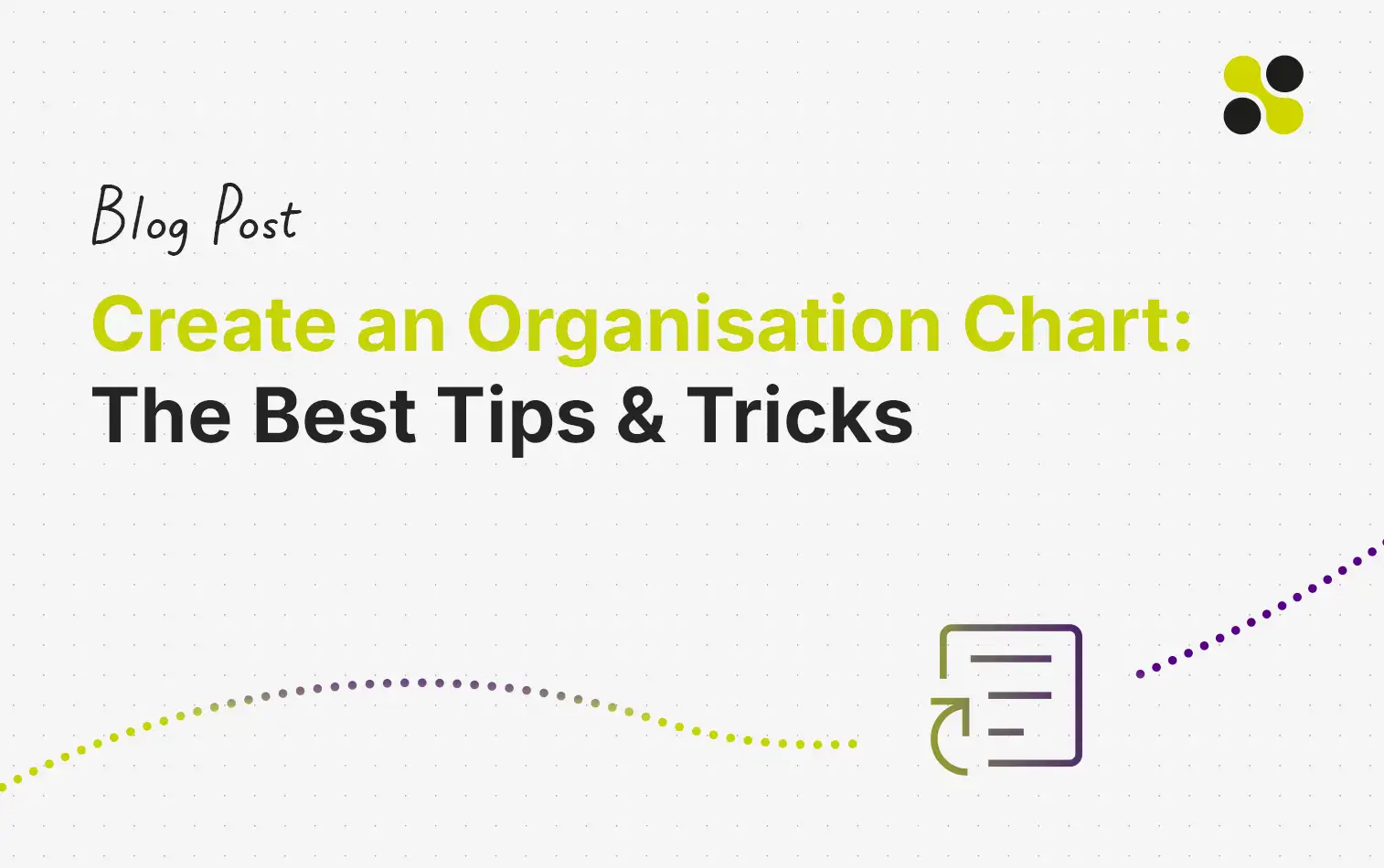A clearly structured organisation chart increases efficiency in teams by making responsibilities and communication channels visible. A professionally designed organisation chart is not just a tool for visualisation, but an indispensable aid to making a company's internal processes transparent.
In this article, you will find out what an organisational chart is and how it is structured. We show you step by step how to create an effective organisation chart and which types are suitable for different requirements. With Collaboard, you can benefit from flexible tools that not only make design easier, but also ensure the highest security standards.
What is an organisation chart and how is it structured?
An organisation chart is a graphical representation of the organisational structure of a company, institution or project. It shows the hierarchies, departments and responsibilities at a glance and helps to clearly visualise the structure. The typical components of an organisation chart are clearly defined units and their connections, which illustrate the relationships and communication channels.
The basic elements of an organisation chart are as follows:
-
Units (boxes or circles): Each unit represents a department, a team or a position within the organisation. They often contain the title or function and, if applicable, the name of the person responsible.
-
Connections (lines): These lines show the hierarchy and communication channels between units. Vertical lines often represent direct authority, while horizontal lines indicate co-operation or equivalent relationships.
-
Hierarchy levels: Organisation charts are usually divided into different levels reflecting the hierarchy - from management at the top to operational teams.
-
Additional information: In some organisational charts, additional details such as contact details, responsibilities or specific projects are included.
A decision is made between the following organisation charts:
-
Vertical organisation chart: The classic variant in which the hierarchy is shown from top to bottom. This is particularly clear for companies with clear management lines.
-
Horizontal organisation chart: This representation is suitable for teams with flat hierarchies and focuses on cooperation between departments.
-
Matrix organisation chart: Several reporting lines are visualised here, e.g. in projects with cross-functional teams.
Step by step: How to create an organisational chart for your company
An organisation chart helps you to visualise the structure of your company clearly and concisely. It provides a basis for defining responsibilities and communication channels and making them accessible to all employees. Use this step-by-step guide to create a professional organisation chart:
1. Define objectives and scope
Before you start creating it, you should be clear about the purpose and target group of your organisational chart. Consider whether it includes all departments or focuses on specific teams. Also clarify whether additional information such as contact details or responsibilities should be integrated. Examples are
- Company-wide organisation chart: Shows the entire hierarchy.
- Departmental: Focusses on a specific team or project.
2. Collect and structure data
Research the relevant information such as departments, teams, roles and reporting channels. Ensure that all data is up-to-date and correct. Create a rough sketch to organise the hierarchy levels.
Tip: Ask team leaders for details to avoid confusion.
3. Define hierarchies
Organise the collected data into a logical structure. Start with the top management level and work your way down step by step. Each unit (e.g. a department or a team) should be clearly recognisable.
Design note: Use colour distinctions for different departments to increase readability.
4. Insert units and connections
Create boxes or circles for each unit. Connect these with lines to show hierarchies or cooperation paths. Make sure that the connections are clear and easy to understand. The following connections are distinguished:
- Vertical lines: Hierarchical reporting paths.
- Horizontal lines: Collaboration between teams.
5. Add details
Decide which details you would like to include in your organisation chart. In addition to the names and positions, you can also add further details depending on the purpose. Useful additions are, for example:
- Contact details such as telephone numbers or emails.
- Location information for companies with several offices.
- Project focal points or responsibilities.
Tip: Avoid too many details on one level to maintain clarity. For complex organisations, you can create additional levels or separate diagrams for sub-units.
6. Design the organisation chart
Now it's getting visual: use a tool like Collaboard to create your organisation chart online. With the flexible drawing tools, you can design your chart intuitively and customise it at any time. Why Collaboard is ideal:
- Intuitive drag-and-drop function: Simple creation and editing.
- Real-time collaboration: Work with your team on the diagram at the same time, regardless of location.
- Secure hosting: Choose between on-premises or cloud options to ensure the highest security standards.
Design tip: Use colours to highlight departments or areas of responsibility. Use symbols to clearly define different levels or roles.
7. Obtain and finalise feedback
Share your organisation chart with colleagues and have it checked. This way you can make sure that no unit is missing and that all connections are shown correctly. Share a draft version with relevant people or teams and ask them to point out any missing or incorrect information. Then make changes based on the feedback.
Once your organisational chart has been finalised, you can use it on various platforms. Publish it on the intranet for employees or add it to internal documentation. You can provide a reduced version for external purposes.
Our 4 tips for your company's organisational chart
An organisation chart not only serves as a visualisation, but also creates transparency about the internal structure of your company. These four tips will help you create a professional and useful organisation chart.
Set clear goals and structure
Maintain clarity
An organisation chart will only be effective if it is easy to understand. Avoid too many details and concentrate on the most important information. For example, names, positions and responsibilities may be sufficient.
Colours or symbols help to visually differentiate between departments or teams. With Collaboard, you can flexibly insert such design elements and ensure that the result remains appealing.
Ongoing updates
Integrate teamwork
Why you should create your organisation chart online
The digital creation of an organisation chart offers you numerous advantages that make the process more effective and flexible. Compared to the traditional method, online tools allow you to save time, manage data securely and improve team collaboration.
-
Simple adjustments: Changes such as new departments or team members can be made easily at any time. This means your organisation chart is always up to date without you having to create it from scratch.
-
Real-time collaboration: With tools such as Collaboard, several people can work on an organisation chart at the same time. This saves time and ensures that everyone involved is always up to date.
-
Design options: Digital tools offer you many layouts, colours and symbols. This not only ensures a clear structure, but also helps to visualise complex relationships in an understandable way.
-
Security: Security is extremely important, especially for sensitive company data. With Collaboard, you can save your organisation chart on your own servers or in a private cloud. This way, the data remains protected and you retain full control.
With an online tool like Collaboard, you can not only save time creating your organisation chart, but also customise and share it. Try Collaboard now for free and design your organisation chart professionally and securely!
Collaboard: your organisation chart tool with free templates
Organisation chart - Frequently asked questions and answers
Is there a free organisational chart template on the Internet?
Yes, many platforms offer free templates, including Collaboard. With Collaboard, you can access practical templates directly and customise them.
Is organisational chart creation free of charge with Collaboard?
Yes, you can test Collaboard free of charge and create organisation charts. For more extensive functions, there are paid plans that are especially suitable for teams or companies.
In addition to the company structure, what are other examples of organisational charts?
Organisation charts can be used for project structures, team overviews or temporary working groups. They are also ideal for planning events or visualising processes.
What are the advantages of an organisation chart tool?
A tool like Collaboard offers flexibility, simple editing and visual design options. You can also save your organisation chart securely and collaborate with your team in real time.
What do many people do wrong when they create an organisation chart?
Too many details are often added, which impairs clarity. Another mistake is that organisational charts are not updated regularly and therefore appear outdated.
How can I share my organisation chart securely?
With Collaboard you can share your organisation chart in a protected environment. Choose between on-premises hosting or a private cloud to maintain the highest security standards.
What visual customisations does Collaboard offer?
Collaboard allows you to flexibly adapt colours, symbols and layouts. This allows you to design your organisation chart clearly and adapt it to your company.




